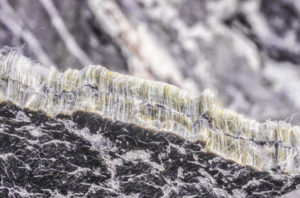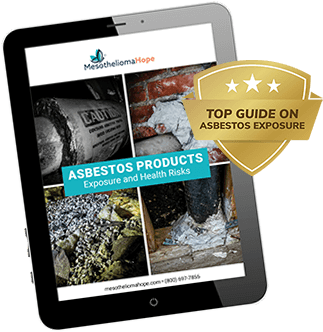Is Asbestos Banned in the U.S.?
No, asbestos has never been completely banned in the United States. However, the EPA recently released a rule that marks an important milestone in the decades-long fight to outlaw asbestos.

On March 18, 2024, the EPA announced a ban on the use of chrysotile asbestos, one of six asbestos fiber types, citing its well-documented carcinogenic (cancer-causing) properties and the significant risks it poses to human health.
About 95% of the asbestos in commercial use is chrysotile asbestos, with the chlor-alkali industry using it to make chlorine and sodium hydroxide (caustic soda) since the late 19th century.
However, with mesothelioma and other asbestos-related diseases claiming the lives of more than 40,000 Americans every year, lawmakers and advocates continue to push for a more comprehensive ban.
“An immediate ban on the import of chrysotile asbestos for the chlor-alkali industry is a long overdue step forward for public health.
However, it cannot be the end of the road when it comes to phasing out other dangerous asbestos fibers, and Congress has a role to play here when it comes to providing stronger protections for our health.”
– U.S. State Senator Jeff Merkley, March 2024
This is the first rule to be finalized under the 2016 amendments to the Toxic Substances Control Act (TSCA), which gave the EPA the authority to conduct risk evaluations of existing chemicals to determine their safety for various uses. Asbestos was included as one of the initial chemicals to undergo evaluation due to its known health risks.
The EPA is still evaluating the five other types of asbestos that haven’t been banned, as well as asbestos-containing talc, and is expected to release its final risk evaluation by December 1, 2024.
Key Facts on Asbestos Bans
- Chrysotile asbestos is most often used to make chlorine bleach products and aftermarket automotive brakes and linings.
- The March 2024 EPA rule doesn’t immediately address legacy asbestos found in older homes, schools, and workplaces.
- The United States is one of the last Western countries to enact a complete ban on asbestos in all its forms.
- Over 60 countries have already banned asbestos, including Canada and the United Kingdom.
Download our Free Asbestos Products Guide to see how and where this dangerous substance is used and how we can help if you’ve been exposed.
Attempts to Get Asbestos Banned in the U.S.
There is a long history of attempts to ban asbestos in the United States, starting in the late 1980s and continuing to the present day.
Alan Reinstein Ban Asbestos Now Act
If passed, the Alan Reinstein Ban Asbestos Now (ARBAN) Act would fully ban all types and uses of asbestos.
The ARBAN Act has been introduced to Congress a total of eight times since 2016. It was last reintroduced in March of 2023 by U.S. Representative Suzanne Bonamici and Senator Jeff Merkley.
“ADAO continues to urge Congress to move forward and pass the Alan Reinstein Ban Asbestos Now Act, which would ban all asbestos fibers and all conditions of use.”
– Asbestos Disease Awareness Organization (ADAO)
The act is named in honor of a mesothelioma victim and advocate who fought for asbestos awareness and regulation before his passing in 2006.
Asbestos Ban and Phase-Out Rule
The Asbestos Ban and Phase-Out (ABPO) Rule was issued in 1989 by the EPA. It called for a complete ban on asbestos manufacturing, importation, and sales.
However, the EPA’s rule was overturned by the U.S. Court of Appeals for the Fifth Circuit in 1991, and some asbestos-containing products are still sold today.
This rule did, however, successfully ban new uses of asbestos, and is still in effect.
Ban Asbestos in America Act
The Ban Asbestos in America Act, also known as the Murray Bill, has been brought before Congress several times (most recently in 2007) but never became law.
The bill aimed to ban the importation, manufacturing, processing, and distribution of asbestos-containing materials and products, and allow the EPA to regulate asbestos. It passed the Senate but failed to make it through the House of Representatives.
Bruce Vento Ban Asbestos and Prevent Mesothelioma Act
The Bruce Vento Ban Asbestos and Prevent Mesothelioma Act was introduced in Congress in 2007 but ultimately failed to be signed into law. It was named after a Congressman who died from pleural mesothelioma. The goal of this legislation was to expand the definition of asbestos and allow more products to be banned under the TSCA.
The act would have allowed the EPA to create additional regulations and prohibitions on asbestos-containing materials with limited exemptions. Had it passed, it would have also required the disposal of all asbestos materials within 2 years.
You may be entitled to compensation if you or a loved one developed mesothelioma or lung cancer from asbestos exposure. Get a free legal consultation now to learn more.
Legislation on Asbestos Regulations: 1970 to 2019
Though asbestos has never been completely banned in the United States, there are various regulations in place that restrict how, when, and where it can be used.
Read more about the history of asbestos legislation below.
Clean Air Act
Originally enacted in 1963 and passed in 1970, the Clean Air Act gave the EPA the authority to designate certain substances as “hazardous air pollutants.”
Asbestos was one of the first substances deemed hazardous in March 1971. The CAA specifically banned asbestos pipe insulation and block insulation on boilers, hot water tanks, and spray-applied surfacing materials that contain more than 1% asbestos.
Consumer Product Safety Act


The Consumer Product Safety Act (CPSA) was enacted by Congress in 1972 with the purpose of protecting consumers from “unreasonable risk” of harm while using a wide range of goods and products.
This act bans the use of asbestos in wall-patching materials and artificial fireplace embers. It also ensures that there are safety standards in place for various consumer products.
Medical Device Amendments
The Medical Device Amendments of 1976 were a set of provisions introduced by Congress that allowed the U.S. Food and Drug Administration (FDA) to regulate the safety and effectiveness of medical devices before they were marketed and sold.
This was important because asbestos-containing materials were historically used in some medical devices and products, particularly surgical gloves, gauze, and other fiber-based products.
Toxic Substances Control Act
The Toxic Substances Control Act (TSCA), passed by Congress in 1976, gave the EPA ability to require record-keeping, testing, reporting, and restrictions related to chemical substances and mixtures.
Several asbestos-containing products are banned under the TSCA, including commercial paper, specialty paper, and corrugated paper.
The TSCA was updated in 2016 under the Frank R. Lautenberg Chemical Safety for the 21st Century Act. For the first time, the EPA was given the authority to impose restrictions or bans on chemicals in order to protect the public. The TSCA amendments also required the EPA to identify the first 10 chemicals to undergo risk evaluation. Asbestos was at the top of the list, and the EPA completed its final risk evaluation for chrysotile asbestos in December 2020.


Have you been exposed to asbestos? See if you qualify for financial assistance.
Asbestos Hazard Emergency Response Act
The Asbestos Hazard Emergency Response Act (AHERA) was passed in 1986 to address asbestos found in schools.
In addition to providing school employees with protection for reporting asbestos, AHERA also requires all public and private K-12 schools to be inspected for asbestos.
Schools must also have management plans in place for handling any asbestos that is found.
Environmental Protection Agency Ruling on Asbestos
In April 2019, the EPA issued its final rule on asbestos. This rule states that asbestos products that were previously banned or discontinued cannot return to the market without being evaluated and restricted by the EPA.
Under this ruling, the EPA can also choose to keep a product as banned or prohibited if deemed necessary.
Asbestos Bans Around the World
Nearly 70 countries worldwide have banned the use, manufacture, import and export, processing, and sale of asbestos.
Here’s a timeline of global asbestos legislation:
- 1983 – Iceland becomes the first country in the world to ban asbestos completely.
- 1992 – Asbestos is fully banned in Italy.
- 2003 – Australia bans the use of chrysotile asbestos after having previously banned both amosite and crocidolite asbestos.
- 2005 – Asbestos is banned in the European Union.
- 2010 – Asbestos is banned in the Middle Eastern country of Turkey.
- 2018 – Canada bans asbestos except in industries where there’s no viable substitute.
- 2021 – Asbestos is banned in 17 states in Brazil.
As more and more countries around the world ban asbestos in all forms, mesothelioma victims and advocates hope the U.S. will one day follow suit.


“Mesothelioma kills innocent people. Asbestos kills innocent people. It’s not banned in the United States, and that is the story. That is the issue.”
International Ban Asbestos Secretariat
The International Ban Asbestos Secretariat (IBAS) is an international non-profit organization dedicated to bringing about a global asbestos ban.
The main mission of this organization is to raise awareness about the dangers and risks of asbestos exposure while working to combat misinformation spread by asbestos companies.
The IBAS also provides support to victims of asbestos exposure and collaborates with researchers and activists.
Download your copy of our Free Asbestos Product Guide to get the facts about asbestos use and learn how to take action if you or a loved one were exposed.
The Fight for a Complete Asbestos Ban: What Needs to Happen?
Specific steps would need to be taken in order to get asbestos banned completely in the United States.
- A bill prohibiting all forms of asbestos would have to be introduced by either a member of the U.S. Senate or the House of Representatives.
- The bill would be reviewed and researched by a committee, then voted on within the house of government where it was introduced.
- Once a bill passes in the first house, it can move to the other house, where it will also be voted on.
- If the bill passes in both houses, it can be reconciled and revised into a single version, and then given to the president for final consideration.
- The president can then either veto the bill or sign it into law. Only Congress can override the president’s decision.
Since 1989, numerous bills have already been introduced to ban asbestos, but they rarely make it through the first house vote.
The ARBAN Act of 2024 has the best chance of being passed, but the government still needs to take swift action on it.


“The ARBAN Act has the support of the House and Senate and is the most comprehensive bill put before Congress in over 30 years.”
Get Help for Asbestos Exposure
If you or a loved one were exposed to asbestos at any point – even if it was decades ago — there are several ways Mesothelioma Hope can help your family.
Our team of Patient Advocates can:
- Get you in touch with local specialists for a cancer screening
- Help identify where you were exposed to asbestos (even if you don’t remember)
- Connect you with top attorneys to help you access legal compensation
- Provide support and guidance at every point in your journey
We’ve helped thousands of asbestos victims find medical guidance, financial assistance, and supportive care. Contact us today or call (866) 608-8933 to request your Free Asbestos Guide.
Asbestos Ban FAQs
Is the U.S. banning asbestos?
The U.S. Environmental Protection Agency (EPA) announced a ban on chrysotile asbestos on March 18, 2024. This the most common of the six asbestos types and has been used in the chlor-alkali industry since the late 19th century.
However, the EPA’s rule gives chlor-alkali production plants up to 12 years to transition away from using chrysotile asbestos.
The March 2024 EPA ban also does not address asbestos-containing talcum powder or legacy asbestos products in structures built before the early 1980s.
Because of this, asbestos could still be found even after the EPA’s ban goes into effect.
The process to completely ban asbestos was approved and started in 1989 but was overturned in 1991 by the U.S. Court of Appeals for the Fifth Circuit after pushback from asbestos companies.
What year was asbestos banned in homes?
Asbestos has never been completely banned in American homes, but asbestos insulation and other asbestos-containing products are no longer used to build new homes.
The EPA issued regulations to phase out the use of asbestos in various products between the 1970s and 1990s.
For example, the Clean Air Act allowed the EPA to regulate asbestos emissions and restrict or banned certain asbestos-containing materials.
However, asbestos-containing materials may still be present in older homes that were built before these regulations were implemented.
Is asbestos illegal?
No, asbestos is not illegal in the United States, but many uses are banned because of its link to mesothelioma and other aggressive cancers.
Has the EPA banned asbestos products?
Yes, the EPA has taken numerous measures toward banning asbestos products, though asbestos still remains in use today.
The EPA has banned:
- The use of chrysotile asbestos (the only type being used or imported in the U.S.) in March 2024
- New asbestos products from entering the market
- Discontinued asbestos products from re-entering the market without evaluation and restriction
Are asbestos products still used in the U.S.?
Yes, asbestos products are still used in the U.S. chlorine manufacturing and oil industries.
However, the use of asbestos products has significantly declined over the last 30 years. Most industries have stopped using asbestos because of lawsuits filed by victims of asbestos-related diseases.
Are any asbestos products banned?
Yes, several asbestos-containing products have been banned.
Examples of banned asbestos products include:
- Asbestos artificial embers
- Asbestos commercial paper
- Asbestos-containing medical devices
- Asbestos flooring felt
- Asbestos wall patching compound
- Spray-applied asbestos products
However, there are still some asbestos products that have not been banned, such as brake linings and gaskets used to manufacture chlorine bleach.
Can you sue for asbestos exposure?
Yes, you can sue for asbestos exposure if you now have mesothelioma or another asbestos-related illness like lung cancer or asbestosis.
You may also be able to file a wrongful death lawsuit on behalf of a loved one who passed away from an asbestos-related illness after being exposed to asbestos on the job or during military service.
Call (866) 608-8933 now to see you can file an asbestos lawsuit.


 Get a Free Mesothelioma Case Review
Get a Free Mesothelioma Case Review




